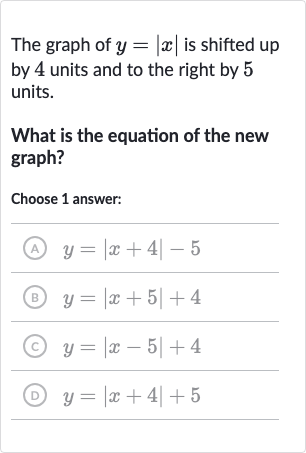Full solution
Q. The graph of is shifted up by units and to the right by units.What is the equation of the new graph?Choose answer:(A) (B) (C) (D)
- Understanding shifts: To determine the equation of the transformed graph, we need to understand how shifts affect the equation of a function. A vertical shift up by units adds to the value of in the original equation. A horizontal shift to the right by units subtracts from the value of in the original equation.
- Vertical shift up: The original equation is . To shift the graph up by units, we add to the -value, resulting in .
- Horizontal shift to the right: To shift the graph to the right by units, we subtract from the -value inside the absolute value, resulting in .
- Comparing transformed equation: Now we compare the transformed equation with the given choices to find the correct answer.(A) is incorrect because it represents a shift to the left by units and down by units.(B) is incorrect because it represents a shift to the left by units and up by units.(C) is correct because it represents a shift to the right by units and up by units.(D) is incorrect because it represents a shift to the left by units and up by units.

